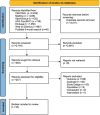Effectiveness of interventions to increase device-measured physical activity in pregnant women: systematic review and meta-analysis of randomised controlled trials
- PMID: 36457104
- PMCID: PMC9713992
- DOI: 10.1186/s12966-022-01379-w
Effectiveness of interventions to increase device-measured physical activity in pregnant women: systematic review and meta-analysis of randomised controlled trials
Abstract
Background: Interventions that provide pregnant women with opportunities to access and participate in physical activity have been shown to be beneficial to their health. Much of this evidence however has been based on self-reported physical activity data, which may be prone to inflated effects due to recall bias and social desirability bias. No previous synthesis of randomised controlled trials has assessed the effectiveness of these interventions using only device measured data, to assess their health benefits more accurately in pregnant women. This systematic review and meta-analysis aimed to address this evidence gap.
Data sources: Cochrane Central Register of Controlled Trials, Medline, SportDiscus, APA PsycINFO, Embase and Web of Science databases were queried from inception up to December 2, 2021. An updated search of PubMed was conducted on May 16, 2022.
Study eligibility criteria: Randomised controlled trials that recruited pregnant women, participating in any physical activity intervention (excluding interventions aimed entirely at body conditioning), compared with standard antenatal care (comparators), using device-measured total physical activity as an outcome were eligible for inclusion.
Methods: 3144 titles and abstracts were screened for eligibility, and 18 met the inclusion criteria. Data were analysed using random effect models, (standardised mean difference and mean difference), using data from baseline to last available follow-up (primary end point), and until between 24 to 30 weeks gestation. Gestational weight gain was also assessed at these timepoints in the included trials.
Results: No significant differences between the groups were found for total physical activity at last available follow-up or 24 to 30 weeks gestation (95% CI 0.03 to 0.27, p = 0.10: 95% CI -0.05 to 0.33, p = 0.15) respectively. On average, pregnant women randomised to a physical activity intervention completed 435 and 449 more steps per day than comparators at last available follow-up and at 24 to 30 weeks gestation (95% CI -0.5-870.6, p = 0.05: 95% CI 5.5-892.7, p = 0.05) respectively. Intervention participants also gained 0.69 kg less (95% CI -1.30 to -0.08, p = 0.03) weight than comparators.
Conclusion: Based on device-measured data, interventions to promote physical activity during pregnancy have small but important effects on increasing physical activity and managing excessive gestational weight gain.
Keywords: accelerometers; device measured; gestational weight gain; pedometers; steps.
© 2022. The Author(s).
Conflict of interest statement
The authors report no conflict of interest.
Figures
References
-
- UK Chief Medical Officers’ Physical Activity Guidelines; 2019 [cited 2022 Mar 30]. Available from: https://assets.publishing.service.gov.uk/government/uploads/system/uploa....
-
- Ruifrok AE, Althuizen E, Oostdam N, van Mechelen W, Mol BW, de Groot CJM, et al. The relationship of objectively measured physical activity and sedentary behaviour with gestational weight gain and birth weight. J Pregnancy. 2014; Available from: https://pubmed.ncbi.nlm.nih.gov/25309754/. Cited 2022 Mar 30. - PMC - PubMed
Publication types
MeSH terms
Grants and funding
LinkOut - more resources
Full Text Sources
Miscellaneous




